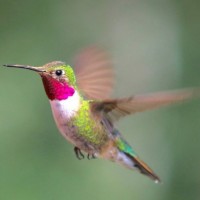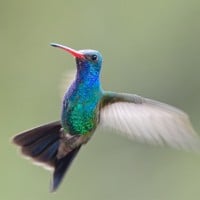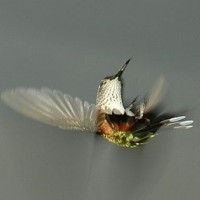Top 10 Most Incredible Facts About Hummingbirds
Many people don't know much about hummingbirds, other than the fact that they're very small birds (the two smallest bird species in the world are both a species of hummingbird!) and that they help pollinate flowers. Usually the population's knowledge doesn't extend much further than that. However, after visiting a few exotic places with amazing hummingbird species, I learned some amazing things about these birds and would like to share some of the most mind-blowing facts about these amazing animals. Enjoy!
I'll leave your mind a couple seconds to process that. 200 times a second! By the time you've finished reading these first three sentences, a hummingbird could have flapped its wings over 5000 times! 200 times in a single second doesn't seem possible. We can probably flap our arms up and down 3 times a second, but hummingbirds can do almost 70x that! Now, the species that can do this, the Ruby Throated Hummingbird, can only reach 200 times a second during courtship dives, which are to impress their mates, and their number of wing beats while just flying is much smaller, a bit under 100 beats a second. They aren't the only bird species of hummingbird that can go at a high pace, though! The average highest number of wing beats per second a hummingbird can produce is about 90, which is still impossibly huge!

This may not sound extremely impressive to you, but this means that hummingbirds can fly backwards while facing forwards, a skill that no other birds have. Most birds can swiftly turn around and fly in any direction, but it's more efficient to not even have to turn around, and to just will yourself to fly in that direction. Their top speed while flying backwards varies depending on the size and species of the bird, but at the most they can fly backwards at over 54 km/h and they can even dive at about 80 km/h! If you're wondering how only these birds are able to do this incredible feat, I'll tell you. They have a thing called a rotator cuff, which all humans have but most other animals don't, and this allows them to move their wings in a figure eight motion, which lets them go in any direction they want while facing a different direction!
Amazingly, a single hummingbird can actually visit and pollinate up to 3000 flowers in one day. Many people look to bees as the number one pollinator, but hummingbirds have a lot to wear on their sleeves as well. Many plants actually wouldn't survive if hummingbirds weren't there to pollinate them! The reason hummingbirds visit all these plants is because nectar is a vital part of their diet and due to their extremely fast metabolism, they have to consume a huge amount of it. As they consume the nectar, they also pollinate flowers because if they visit another flower of the same species, which is likely, some of the nectar from the first flower will pollinate the second. The average number of flowers visited by a hummingbird in a day is more around 1500, but they can do much more if they're hungry and a fast flyer!

Just like how they can fly backwards, hummingbirds can also fly upside down, with their head to the ground and legs to the sky. Obviously, birds aren't meant to fly upside down, and hummingbirds, while they have the instincts to fly backwards if they ever need to retreat or if it would be more efficient than turning and flying forwards, the instincts aren't there to fly upside down as it really doesn't serve them much, other than it being a neat party trick for an animal that doesn't have parties. However, people have observed these birds flying upside down on multiple occasions, though usually not for more than a couple seconds before the birds go back the right side up, and it's really cool to watch videos of them doing this feat!
To put it into perspective for you, the average human adult's heart rate is from 60 - 100, decreasing as you get older, although some people have much higher or much lower heart rates than the average. Hummingbirds, on average, beat their hearts at a rate of around 250 beats per minute, and even while resting, it usually stays above 200. If a human's heart rate goes over 180 beats in a minute while working out or sprinting or whatever the cause, it can get dangerous, and any higher than that, you can risk getting a trip to the hospital or you have a medical condition that causes your heart rate to go so high. So, as hummingbirds can reach 1200 heartbeats in a single minute, about 20 heartbeats a second, with no problem, they are pretty incredible animals.
Hummingbirds aren't the only animals who eat an extreme amount. Sometimes, snakes like pythons can eat entire animals the size of humans in one sitting, though they won't eat again for a few months. When pandas aren't sleeping, they pretty much spend the entire day eating! But even with pandas constantly eating for the entire day, at the most the highest amount of food they eat is just 2 times their body weight, whereas the hummingbirds can consume 8 times their body weight, which isn't actually a lot of food, but for such a tiny animal, it's amazingly high! Most of this incredible diet comes from all the nectar they consume throughout their day in the process of pollinating flowers, but they also eat small insects, and sometimes other things like pollen. On average, hummingbirds consume much less than 8 times their body weight, as it depends on the bird and the number of flowers they can visit, but they have been recorded eating this much.
This was hard to believe when I saw it for the first time, but after multiple sources confirmed it, it turns out that it's true! Hummingbirds have extremely long tongues, probably the longest for any species in proportion to their body weight, because not only does it have to be the length of their very long beaks, but it has to extend much further than even that for them to drink lots of nectar in a process called capillary action. Their tongue actually extends all the way out, laps up nectar, and goes all the way back in more than an amazing 12 times a second, so they can finish off all the nectar a flower has to offer in a second or two! when it's not fully extended to consume nectar, it's so long that they have to wrap it under the jaw, then behind and over the head, which is amazing!
Another thing about hummingbirds is that they're really smart! Hummingbirds actually have the largest brains compared to any other bird (that is, in proportion to their body weight), as well as most other animals! For example, humans' brains make up 2 percent of their body weight, which is a fair amount, but hummingbirds more than double that at around 4.2 percent! They have a very good memory, and usually have a good idea of where every flower in their territory is and how long it takes to refill with nectar.
In comparison with other birds, hummingbirds have to clean their feathers an extremely high amount! All birds do this, and it's called preening, but in hummingbirds, the state of their feathers is actually a life or death issue, because if they don't do it very often, and if dirt or other stuff gets in them, it can weight down their incredibly light bodies to the point that they can't fly, and if they can't fly, they can't eat, which can make them starve extraordinarily fast, as they can only last 3-5 hours without food.
While birds are usually pretty light in weight due to feathers and hollow bone to help the air currents give them some extra lift while flying, hummingbirds are even tinier than that! Some hummingbirds do weight as much or even more than a nickel, but the majority are smaller in weight and many are actually even lighter than a dime or a penny, which is pretty crazy when you think about it, as it's imagine that a bird with such complexity could be so light!